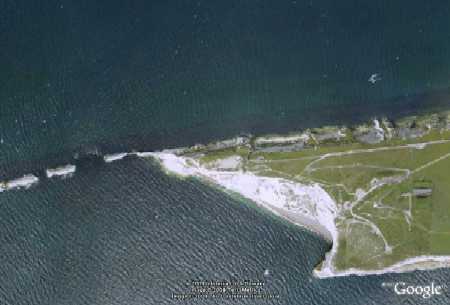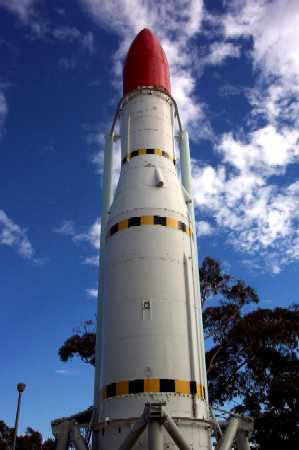High Down Isle of Wight
Eight miles from Hengistbury Head, directly across the Solent lie the white chalk cliffs of the Isle of Wight with the Needles Light House marking the western most end of the Island. The southern area of this western tip of the Isle of Wight, an area known as High Down, was, not so long ago, a top secret rocket testing site. It was finally closed in 1971 after the cancellation of Britains independant satellite launch program.
Today few people know that the UK had a satellite launch program, let alone that a satellite was successfully launched using an innovative small rocket called Black Arrow. All of the launch vehicles for the Black Arrow program were "live" tested at High Down, just across the Solent from Hengistbury Head. No rockets ever left the launch pad at High Down but were shipped to Woomera in South Australia for launch.Britain is the only country in the world to have developed a successful satellite launch capability and then abandoned it.

The High Down Rocket Testing Site and the Needles from Google Earth. The test gantry Pads are bottom right
High Down was first built to test Black Knight rockets. These were research rockets being used to evaluate the design of the re-entry vehicle for a nuclear warhead in the late 50's and early 60's. The Black Knight rocket used a mix of Hydrogen Peroxide and Kerosene for fuel. Hydrogen Peroxide first came to promenence in the second world war as part of the fuel used by the German Me163 Komet Rocket fighter (the Germans called Hydrogen Peroxide T-Stoff). After the war, the British took to developing a range of vehicles that used Hydrogen Peroxide as the oxygen producing element of the fueling system. These vehicle ranged from submarines, torpedoes, rocket fighters (example, the Sauders Roe SR53, also developed on the Isle of Wight) and research rockets such as Black Knight.
The very high strength Hydrogen Peroxide used was 85% pure and is called HTP (High Test Peroxide). It is highly dangerous, although arguably less so than most rocket fuels. Weak Hydrogen Peroxide (3%) is commonly used to bleach hair. Hydrogen Peroxide has recently acquired some notoriety as part of a a terrorist explosive. Islamic extremists tried to use it as part of their bomb equipment in London.
The Black Knight research rocket had performed impeccably with no failures. Due to this success, a decision was made to develop a cheap, low cost satellite launch system using the technology originally developed for the Black Knight. So was born the Black Arrow commercial satellite launcher.
Below are a set of 3 excellent short YouTube videos by Joe Myerscough and Mat Stracy that detail the history of Black Arrow with interviews and recollections from those involved. There are also many impressive views of High Down and rocket launches and rocket tests (particularly Black Arrow).
(Note: Single click to view the small video, double click to open a new window to view larger video.
A test at High Down (either Black Knight or Black Arrow) involved clamping the rocket to its base. The engines were fired and the escaping hot gases were directed down blast chutes through casquading water, the result was that huge quantities of steam were thrown up and drifted away with the wind. Often the Needles were enveloped in a cloud of steam.
I remember seeing and hearing a number of High Down tests around 1968-1970 from the beach at Mudeford (a distance of about 9 miles). Of course I didn't actually know at the time what these were, but this is typically what happened.
On one occasion, I think it was early spring 1969 or 1970 I was looking over to the Needles. A white cloud, somewhat like a fog bank drifted down westward from behind Isle of Wight and enveloped the Needles. While it was drifting down there came the roar of the rocket engines. Although I am (and was) a bit of an aircraft buff, the sound of the rockets was sufficiently different from a gas turbine engines for me to be unable to place them. The roaring stopped after what felt like only a few seconds. I imagine there was no need to test for much longer than this to prove the Rockets viability. I thought no more of it, but it had obviously made a strong enough impression on me to remember the events. It was not until many years later that I found out about the High Down rocket testing.
(NOTE: I have amended this section a little, after all, this is a 40 year old memory!. Further more, as the needles were enveloped in steam, then the test had to have taken place on a day when the wind was blowing from the East. As this is fairly unusual it should be easy to identify which test this was, if we knew the weather data at time of test. However this must have been either R2 or more likely R3).
Of the five Black Arrow launch vehicles 3 were designated for systems testing and 2 for satellite launching. All the launched rockets were tested at High Down before being shipped to Woomera.
The first test (R0) at Woomera was a failure, with a rocket direction control failing. The rocket had to be destroyed by remote control.
The second test (R1) was successful but was not intended to reach orbit, being purely a systems test.
The third launch (R2) was intended to reach orbit but due to a fuel leak in the second stage it fell back to earth.
The final launch (R3) successfully placed a satellite ( called Prospero ) into orbit even though the project had already been cancelled.
The final launch only took place because the Black Arrow team were already on their way to Woomera when the cancellation was announced. Evidently nobody told the team "officially" in writing that the programme had been cancelled. As they were almost there, they went ahead and lauched R3 anyway.
The successful launch caused considerable political embarrasment but the cancellation remained. Rumour has it that the minister in charge was so apopleptic with rage he demanded that everyone on the project should be sacked. As it was, after the cancellation 50% of this highly skilled and dedicated workforce ended up on the dole
The last launch vehicle (R4) was never launched. For many years it formed a centre-piece in the Science Museum in London. It was one of the great "could have beens" of British Engineering but ended up hung from wires showing the world what a modern (though abandoned) satellite launcher looked like. Maybe it also showed just how badly the UK had lost confidence in itself.

The Black Arrow mock-up in Woomera Museum Australia.
A Black Arrow launcher was diminuitive compared to most launchers of its day. Along with its novel and revolutionary fuel, its size makes it stand out against most other launch vehicles.
Statistics
Height: 13m
Diameter: 1.98m
Weight: 18130Kg
Satellite weight:73Kg (launched)
Orbit: Low Earth Orbit
The Black Arrow project was massively underfunded and yet, for the money, achieved staggeringly successful results. It was, after the last launch, a proven and cost effective satellite launching vehicle. Black Arrow inevitably is, and was, compared to its contemporary massive American Saturn V rocket which was used for landing men on the moon. The comparison invariably makes Black Arrow look puny and insignificant. But really, this comparison is bogus. It is like comparing a massive ocean liner to a racing yacht. They may both be at the top of their game and yet almost any comparison of performance will favour the ocean liner. Black Arrow was designed to launch small satellites into low earth orbit. Saturn V was used to land men on the moon.The Americans designed and still utilise a range of launch vehicles. The vehicle selection depends on the payload and mission.
At the time the direct American competitor to Black Arrow was a small satellite launcher called Scout. If my memory serves me correctly the first seven attempted launches of Scout ended in failure. But the Americans had the strength of their convictions and Scout went on to be a great success.
Unfortunately the fate of Black Arrow was decided by people who may well have had a double first in Classics from Oxford, but technically could barely wire a three pin plug. Their erroneous view of an inability for Black Arrow to compete was almost certainly clouded by a perception that it was Black Arrow competing against Saturn V rather than Black Arrow competing against Scout. The people making the decisions lacked the technical and marketing skills to appreciate what they had. That, coupled with the fact that the country was virtually bankrupt sealed Black arrows fate.
Today Prospero still orbits the earth and passes over us twice a day. Her telemetry was turned off in 1996, although there have been rumours that you can still pick up signals from her internal timing systems. Meanwhile the equivalent (though arguably less capable and more expensive) American Scout rocket went on to launch more than 100 satellites and was only taken out of service in 1996. During most of its life, the Scout launcher had no competitors and effectively held a lucrative monopoly for launching small satellites for the rest of the world (including British satellites)
The final bitter word on the demise of the British satellite launcher program was perhaps given by an anonymous engineer who gave the Prospero satellite its final name. The satellite was actually going to have the Shakespearean name "Puck" (from a Mid Summer Nights Dream) but it was renamed Prospero after the cancellation was made public. Prospero was a great and wise wizard in the Shakepearean play "The Tempest". Prospero laboured for many years learning his mystical art. But at the end of the play he abandons his tools and so loses his powers.
And that is how it is today. High Down is a ghostly set of concrete pads and blast chutes. The buildings (except for the old Napoleonic fort) have long gone. No clouds of steam have wafted their way toward Hengistbury Head for over 40 years. Highdown rocket testing site along with the skills developed there, lies rusting and forgotten.